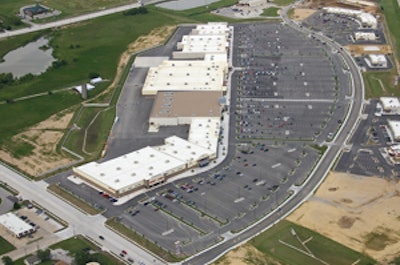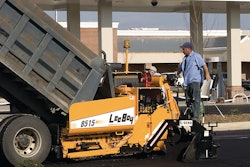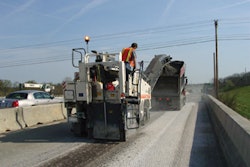
We don't fight them, we work with them," says Nathan Ellsworth, vice president of Ellsworth Construction Co., an Oklahoma paving contractor that has spent the last few years stepping up from small jobs to large parking lot projects. And it's that "work with them" approach that has fueled the contractor's recent growth, enabling it to integrate the large paving projects with the smaller projects that have been the company's mainstay for years.
Ellsworth says that until recently the company did not pursue large jobs because the contractor didn't think they could be competitive on the big jobs while still making a good profit.
"The work was always out there, we just didn't go after it," Ellsworth says. "For the longest time we just sat in place and waited for someone to call us to place some asphalt. Now we're just stepping up into the arena and taking our chunk of it.
"The smaller jobs are our bread and butter and we have to keep them going no matter what other jobs we take or how big the other jobs are," Ellsworth says. "In 2005 we ran one crew and we realized if we were going to commit to those large projects we were going to have to do something different."
So they added a second paving crew – and the equipment to support it – and "decided to seize the opportunity."
"We just decided we were going to try to build the business rather than keeping it status quo," Ellsworth says. "That doesn't mean we're all of a sudden going to be bidding Highway 169 jobs, but construction of a new hospital or resurfacing of airport runways is something we will definitely compete for now."
Phasing work on a big job
One of the big jobs the company decided to pursue was Smith Farms, a massive retail and restaurant development covering more than 66 acres in Owasso, OK. Ellsworth Construction was hired by the grading contractor, who had already installed a 6-inch aggregate base, along with concrete curb and gutter.
"Before we started the Smith Farms job we talked about it with the crews. We wanted to make sure they understood that this project is one of Owasso's jewels as far as commercial development is concerned," Ellsworth says. "We always do an exceptional job and we told our crews we know that, but we also told them that this job was especially important to the city of Owasso and especially important to us as a contractor. We let them know it's important to our company and we stressed quality on the job. And the crew really stepped up."
The first phase of the job required Ellsworth Construction to build an 1,800 foot x 30 foot crowned road connecting two main streets 10 blocks apart. The crews installed 4 inches of a base mix (A mix) with 1½ inch rock, followed by 3 inches of a less-coarse 5/8-inch binder mix (B mix), and finished with a insoluble mix of 5/8 inch rock (B Insoluble mix).
Ellsworth Construction was required to meet mat temperature specifications during the job and density requirements at the end of the job. The city of Owasso inspected the road throughout the paving process because they had to buy back the road from the developer. Knowing that the overall maintenance of the road would be paid by the taxpayers of the city, Owasso inspectors made sure all material and applications were within specification.
Because the city was especially concerned about the finish on the road surface, Ellsworth Construction used a pneumatic roller to complete compaction. Once officials from the city of Owasso approved the final road, Ellsworth moved on to paving the parking lot.
But because other construction was occurring throughout the 42 days they worked on Smith Farms, Ellsworth Construction had to phase the paving to accommodate other contractors and to avoid conflicts.
"The general contractor didn't want crews paving near the building while other construction crews, such as the masonry crew, were working there, so the job required that we worked a little differently than we normally would," Ellsworth says. "We were at their mercy as far as where we could start and where we could pave, but we knew that was going to be the case going in so we bid the work with that in mind."
The parking lot pavement consisted of a 6-inch aggregate base, 3 inches of surface mix in the light duty sections, and 2½ inches of base mix finished with 2 inches of surface mix in the drive lanes and behind the buildings where trucks load and unload.
Ellsworth Construction relied on a LeeBoy 8515 paver and two Ingersoll Rand rollers (DD70 and DD34 HF) for the job.
One of the differences between this job and others is Ellsworth's crews had to pave toward the buildings rather than away from them. "Because of all the other work going on with the buildings we couldn't start paving at the building and pave toward the road," Ellsworth says. "We had to pave the road to the building and we would like to have paved the building to the road because that's the way the water flows, so we were actually paving uphill."
Another difficulty Ellsworth encountered because of the way the paving had to be phased was that the paving crews couldn't completely finish paving one area before moving on to the next. Instead, they would pave an area, around the anchor Target store for example, but then would have to move out of the way so other contractors could move in and out of the building to get their work done.
"Because of the way we had to phase the job we were ending a lot of the paving right in the middle of the parking lot," he says.
So Ellsworth's crew would pave what they could, then roll off the paving, creating a smoother transition between the one lift and the next.
"We didn't want to just stop the paving and construct a hard vertical edge because trucks driving over that would just damage it," Ellsworth says.
The result was that the job required an unusually large number of tie-ins once Ellsworth's crews could get back to the paving. And while the crews could have paved over the roll offs, the integrity of the pavement would have been compromised so the crews took an extra step or two to improve the finished work: Ellsworth decided to saw cut the tie-ins to ensure a quality joint. Plus, the crews staggered the saw cuts so there wouldn't be one continuous joint running throughout the job.
"Saw cutting them wasn't in the contract but when we realized how many there were going to be because of the phasing we just decided the right way to pave it was to saw cut them first," he says.
He says the crew used a pavement saw to cut a straight line about 10 inches back from the end of the pull.
"We went back that far to make sure we could get a good vertical edge to start paving against," he says.
The crews then applied a tack coat to the vertical edge of the cut, then paved against it. Ellsworth says the combination of the saw cutting and the tack coat improves the joint and will extend the life of the pavement.
'We couldn't pave it the way we pave most jobs because of the other work that was going on at the same time. But at least this way the pavement will last longer.
"It was a challenge with all the tie-ins but we went the extra mile because we wanted it to look nice," Ellsworth says. "The guys had to pay more attention, make the joints look nicer, they had to be conscientious and do a good job."
He says that cutting the tie-ins is just part of the service Ellsworth Construction tries to provide its general contractor customers.
"We like to think that we go the extra mile, and that's an example," Ellsworth says.
Another example is how Ellsworth handled perhaps the biggest blow to the job, which the contractor encountered after the parking lot was half paved.
"The general contractor told us that the irrigation contractor forgot to run irrigation to the islands, so they had to cut through the pavement and lay the irrigation lines," Ellsworth says. "We told the GC that if they saw cut the asphalt and prepped the sub-base after the lines were installed we would patch the areas back with asphalt at no charge. We felt that by helping all parties involved it would pay dividends to us in the long-term. It's just another example of how our company tries to work together with other contractors to get the job done.
"That wasn't part of the original contract, of course, because it came up unexpectedly. But the GCs we work for know we do more than just pave," Ellsworth says. "We provide a service and that service is to take care of their problems if we can and if it's reasonable to do so. Fixing those cuts for the irrigation lines was something we could do to help them out and we know that effort on the part of our crew will pay dividends later. Work hard and take care of your customers. That's where it's at."
Large jobs drive growth
It's clear that the change in the company's mindset has resulted in their recent growth. Ellsworth Construction employs 31 people, including 6 sales and office people, and 25 field personnel. Ellsworth operates two full-time paving crews, one full-time sealcoating crew, and an infrared truck "that we keep pretty busy."
It's certainly a different company than when it was founded by Nathan's father 30 years ago. Ellsworth Construction started as a sealcoat company in the early 1970s when the founder, Robert Ellsworth was in his mid-20s.
"My father had a liquid asphalt cement distribution and trucking business. He thought it might be a good idea if I started applying road oils for various counties on rural roads. So I bought an old distributor truck and got to work." Robert says. "From there I began maintaining parking lots by offering cracksealing services and sealcoat services. Eventually customers began asking us to do overlays and patch work and the business evolved into a small paving operation."
The company added paving to their services in the early 1980s when they bought their first paver, a Puckett power box, "and we've just grown from there." Ellsworth says the bulk of growth has been in the last five years and most of that in the last couple of years.
"I don't know if it's the economy or the way we've begun to approach going after business, but our growth has doubled every year for the last three years or so," he says Ellsworth says the larger projects require a different approach than their typical smaller jobs, and the company and its crews have made the adjustment.
"You've got to be real competitive on these bigger projects. You need productivity to make any money," he says. "The combination of the big jobs and the smaller jobs is key to our success. It's a good mix, a good balance."











![Lee Boy Facility 2025 17 Use[16]](https://img.forconstructionpros.com/mindful/acbm/workspaces/default/uploads/2025/09/leeboy-facility-2025-17-use16.AbONDzEzbV.jpg?ar=16%3A9&auto=format%2Ccompress&fit=crop&h=135&q=70&w=240)








